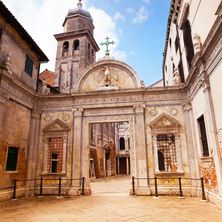

One of the first confraternities to be founded in Venice, the Scuola Grande of St. John the Evangelist possesses an extraordinary relic: a piece of the true cross, that is, the cross on which Christ was crucified. The founders of this charitable organization were a group of flagellants, who during religious ceremonies would whip their backs and sprinkle the ground with their blood. The city's authorities prohibited the rite, however, precisely in the year the Scuola was set up: 1261.
In 1369 Philip de Mezières, Chancellor of the Kingdom of Jerusalem and the Kingdom of Cyprus, donated to the confraternity a piece of the true cross. This gift became a sensation in Venice and the Scuola soon flourished into a rich and powerful institution, attracting the patronage of important members of Venetian society. The relic became even more phenomenal after a so-called miracle that took place in the 1370's. During a crowded procession the piece of the true cross accidently fell into a canal and when people dove in to rescue it, it avoided everyone except Andrea Vendramin, the head of the Scuola Grande di San Giovanni. Many prominent painters later immortalized this incredible event on canvas.
The actual church and monastery that we see today were completed by the middle of the 15th century and in 1485 Pietro Lombardo added the Scuola's most exclusive feature: the polychromatic Renaissance gate separating the square from the courtyard. Above the gate's entrance, on the semi-circular pediment, protrudes an eagle on a pair of scrolls - both symbols of St. John the Evangelist.
The interior consists of a number of beautifully furnished rooms. On the ground floor there is a large hall, known as the Hall of Columns. This space, part of the original 14th century building, was where the brothers and the pilgrims coming to the institution would gather and discuss their activities. Today it is often used for exhibitions. There are two smaller rooms on the lower floor: the Green Room, a former warehouse and office; and the Blue Room, also used for administrative purposes. The upper floor is reached by Mauro Codussi's double staircase, "il Scalone Monumentale". Lit by round-headed windows, it is domed and vaulted. The stairs lead to a large upper room, the "Salone," which was redecorated by architect Giorgio Massari in 18th century. Beyond the "Salone" is the most important room of the confraternity, the Oratory of the Cross. It is here that the piece of the true cross lies in a Gothic reliquary. Beyond the Oratory is the "Sala Dell'Albergo," in which the Scuola's government held their meetings.
Among the most important works to have been painted for the confraternity were by Pietro Perugino, Lazzaro Bastiani, Giovanni Mansueti, Vittore Carpaccio, Gentile Bellini and Titian. Perugino's canvases have not survived to this day, but the other artists' works can been seen at the Accademia Museum. The most famous of these are Carpaccio's Miracle of the Relic of the Holy Cross, Bellini's Procession of the True Cross, one of the first paintings to present a very detailed view of St. Mark's Square, and Bellini's Miracle of the Cross at the Bridge of San Lorenzo, which shows confraternity leader Andrea Vendramin retrieving the cross from a canal. Titian's St. John's Vision today hangs in the National gallery of Washington.
There are, however, three works that have not been removed from the confraternity and which can be seen today in their original positions: Domenico Tintoretto's Transfiguration of Christ, Giandomenico Tiepolo's Four angels and four evil winds and a series by Jacopo Palma the Younger dedicated to the cross. The Scuola Grande di San Giovanni Evangelista is an exquisite treasure hidden in the labyrinthian streets of Venice. Visits are arranged only by appointment.